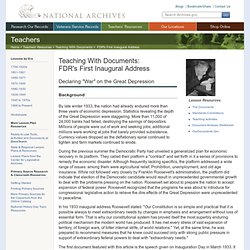

Teachers Overview - The American Dream - Lesson Plan. Back to Lesson Plans Lesson Overview This lesson invites students to search and sift through rare print documents, early motion pictures, photographs, and recorded sounds from The Library of Congress. Students experience the depth and breadth of the digital resources of the Library, tell the story of a decade, and help define the American Dream. Objectives Students will: analyze, interpret, and conduct research with digitized primary source documents interpret 19th and 20th century social life in the United States using digitized documents from the Library of Congress define, present and defend their ideas about what the American Dream has been, through the decades relate what they have uncovered from inquiry and research to their own American Dream Standards Time Required Two to three weeks Recommended Grade Level Topics Culture & Folklife Immigration & Ethnic Heritage Eras Great Depression and WWII, 1929-1945 Postwar United States, 1945-present.
Video: Dorothea Lange, Migrant Mother, 1936. Photographs from the FSA and OWI. Most images are digitized | All jpegs/tiffs display outside Library of Congress | View All The photographs in the Farm Security Administration/Office of War Information Photograph Collection form an extensive pictorial record of American life between 1935 and 1944.

This U.S. government photography project was headed for most of its existence by Roy E. Stryker, who guided the effort in a succession of government agencies: the Resettlement Administration (1935-1937), the Farm Security Administration (1937-1942), and the Office of War Information (1942-1944). The collection also includes photographs acquired from other governmental and non-governmental sources, including the News Bureau at the Offices of Emergency Management (OEM), various branches of the military, and industrial corporations.
For a video overview of the collection, see "Documenting America, 1935-1943: The Farm Security Administration/Office of War Information Photo Collection. " Research Tips. FDR's First Inaugural Address Declaring 'War' on the Great Depression. Background By late winter 1933, the nation had already endured more than three years of economic depression.

Statistics revealing the depth of the Great Depression were staggering. More than 11,000 of 24,000 banks had failed, destroying the savings of depositors. Millions of people were out of work and seeking jobs; additional millions were working at jobs that barely provided subsistence. Currency values dropped as the deflationary spiral continued to tighten and farm markets continued to erode. During the previous summer the Democratic Party had unveiled a generalized plan for economic recovery in its platform.
In his 1933 inaugural address Roosevelt stated: "Our Constitution is so simple and practical that it is possible always to meet extraordinary needs by changes in emphasis and arrangement without loss of essential form. The first document featured with this article is the speech given on Inauguration Day in March 1933. Resources Graham, Otis L., Jr. Leuchtenburg, William. Sgt. A Depression-Era Anthem For Our Times. A bread line forms outside of the Rescue Society in New York City in 1929.

"Brother, Can You Spare a Dime? " directly confronted the hardship of the Great Depression. Wikimedia Commons hide caption toggle caption Wikimedia Commons A bread line forms outside of the Rescue Society in New York City in 1929. Hear five versions of the song, including one by lyricist Yip Harburg himself. Brother, Can You Spare a Dime? Yip Harburg (1970) NPR's Senior News Analyst Daniel Schorr Lyricist Yip Harburg and composer Jay Gorney talk about their song, "Brother, Can You Spare a Dime? " How The Song Got Its Title (Gorney) How Yip Harburg Began Writing Songs (Harburg) Social Consciousness Of The Song (Harburg) On Oct. 29, 1929, the U.S. stock market crashed. In 1932, a young New York City lyricist named E.Y. Deconstructing a Classic Kapilow says that the mood of the song is guided by its key and its rhythm. All of that, Kapilow says, provides a wonderful set-up for the perfect punch line: the song's title.
Destitute pea pickers in California. Mother of seven children. Age thirty-two. Nipomo, California. National Steinbeck Center. OF MICE AND MEN - The Student Survival Guide.